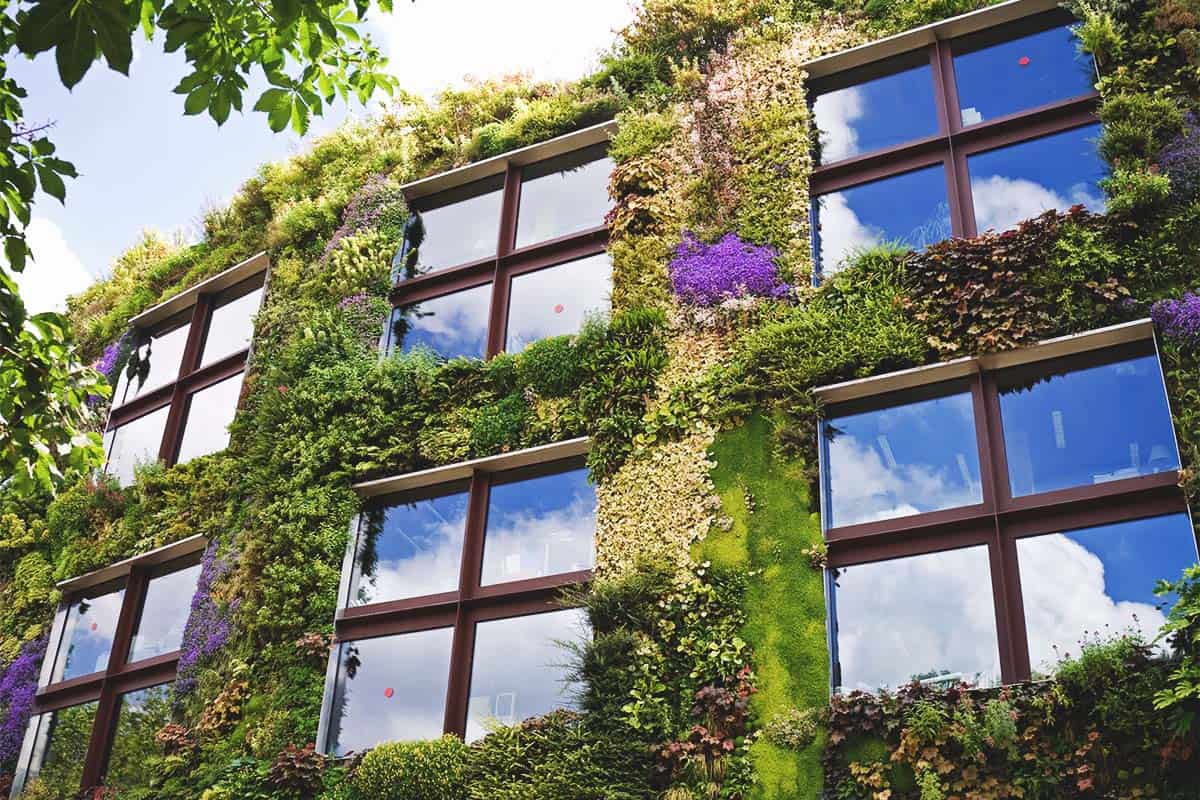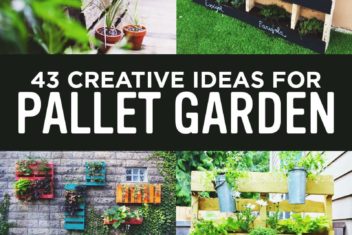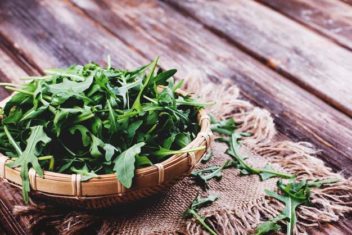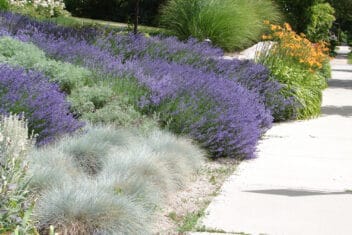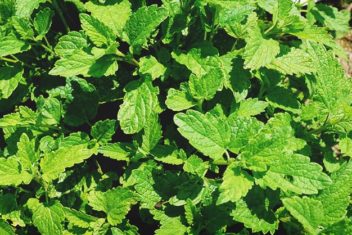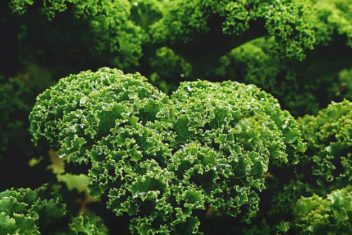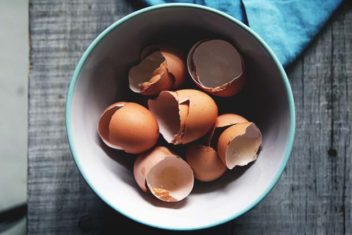Living walls are vertical gardens that let you bring greenery and nature to even the smallest space. They can be used on the inside or outside of your house to provide a space for food, decoration, privacy, or even to freshen the air.
In other words, living walls are a way to bring greenery to areas that might otherwise be bare, like a brick wall, a spot in the kitchen, or a patio fence.
Green walls are perfect for bringing nature back into urban environments, but that doesn’t mean you can’t use them in even the most remote locations. They work in any space as long as they have light and water.
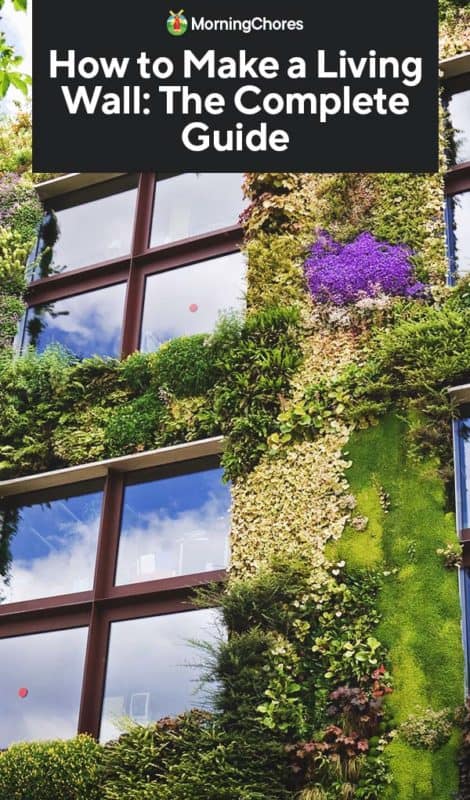
What Is A Living Wall

Living walls are also referred to as vertical gardens, green walls, or eco-walls. They were first patented in 1938 by Stanley Hart White and are a sci-fi dream come true.
There are many styles of vertical walls and they make an easy DIY project. If you want something pre-made, pocket panels, hanging grow bags and wooden planting units are available online to make things easier.
A living wall is made from connected vertical sections or boxes that hang on the wall or stand on their own. Since they are vertical they don’t take up much floor space.
Some living walls are made out of rows of planters, while others have individual plant holders.
Many green walls are built to include an irrigation system to make watering easier. You can, however, choose not to put in any tubing and just water the plants by hand.
Why Should You Grow a Living Wall?
Living walls may help improve the air quality of your home. When houses are built they have numerous chemicals in the wood, carpeting, and paints that off-gas over time. Not to mention all those pollutants creeping into your house from the outdoors.
There’s some evidence that plants filter some toxins, such as VOCs, carbon monoxide, formaldehyde, and benzene. This makes for a healthier home. In addition, the plants take in carbon and expel oxygen.
Plants also reduce noise because they naturally block high-frequency pitches. Studies have shown that plant walls in the work environment help employees because they reduce noise. Plants also make us feel calmer.
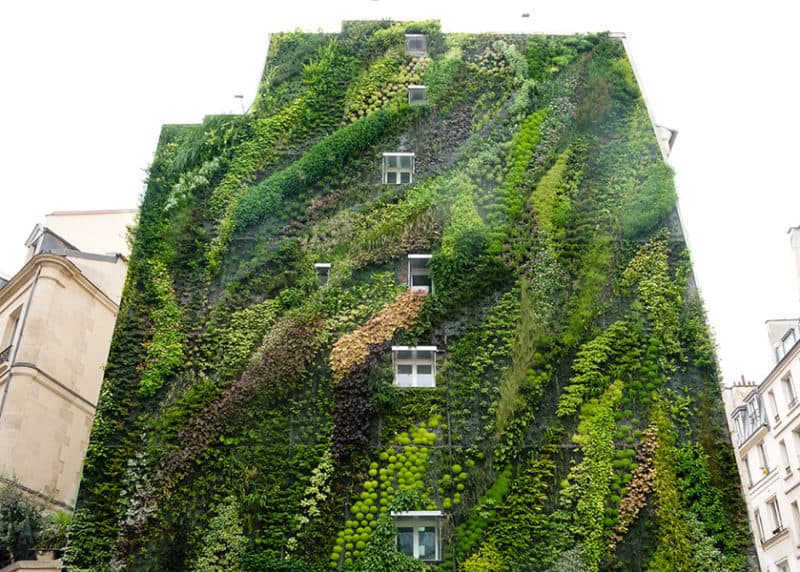
Living walls can provide shade and cooler temperatures around the home. In fact, they’re being applied to building exteriors in cities to help reduce the heat that builds up in paved areas. In the home, a green wall around a patio or deck can provide shade as well as additional privacy.
A vertical growing space also makes a great area for growing veggies without taking up space you may need otherwise. Cascading tomatoes, strawberries, green beans, and Asian eggplants all do well as long as the boxes allow enough room for proper root growth.
What Do The Plants Need?
When creating your living wall you need to consider the light, nutrition, and water needs of the plant. This is an important step because these factors determine how much time you need to devote to your plant wall and how successful it will be.
Lower maintenance plants are good candidates for your wall because they can flourish without much fussing. Plants such as ferns, herbs, succulents, mosses, and low ground covers work well on walls.
When choosing plants, consider texture, shape, form and the color of foliage and flowers. Is the plant edible or ornamental (or both)? Plants that are relatively compact fit happily in a smaller space. They should also be able to handle regular pruning.
Best Plants
Succulents
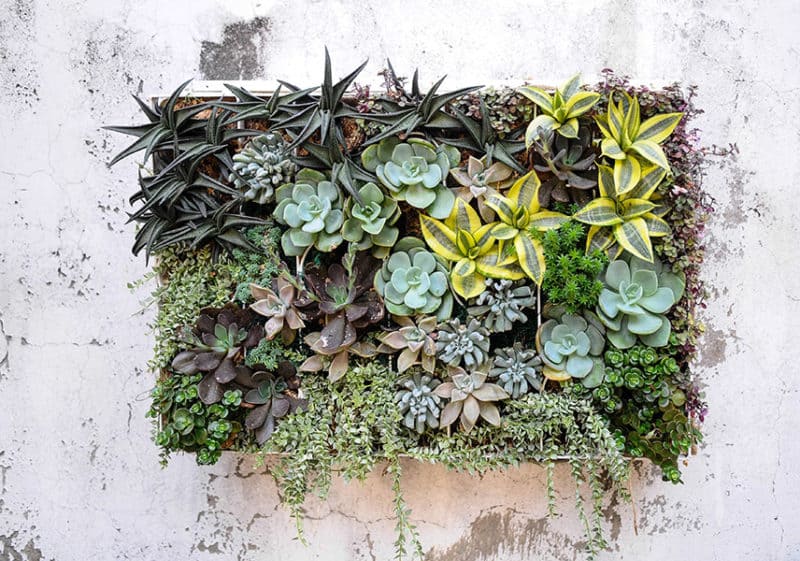
Succulents are some of the best options for indoor walls or outdoors in a warm climate. They’re easy to grow, so they’re great for beginners. They grow happily in confined areas.
Check the zone recommendations if you’re using them outdoors since they don’t tolerate freezing temps. Also, succulents benefit from a light potting soil with sand and vermiculite added.
Hen and Chicks
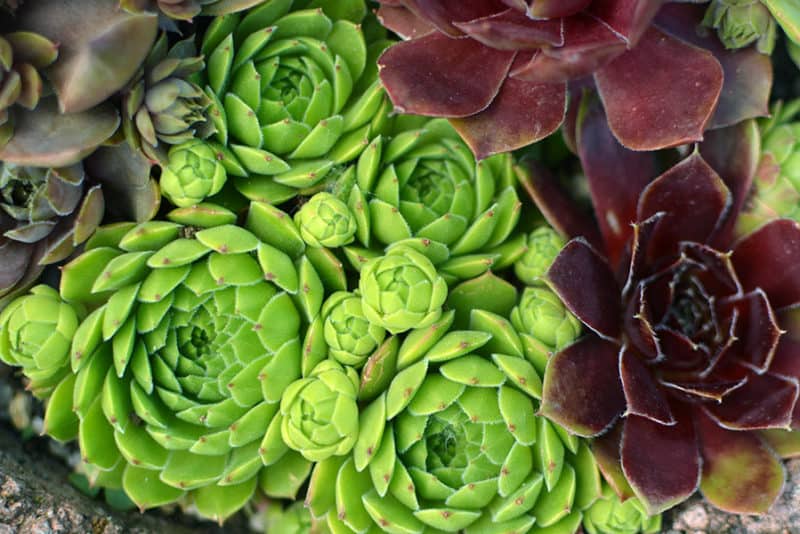
These succulents have a rosette flower leaf pattern and a tall flower spike. Echeveria is an excellent variety and looks stunning in a vertical garden. For added fun, you can arrange them in a geometric pattern. The flower stems can be a bit intrusive and messy so prune them as needed.
Sempervivum is another classic hen and chicks succulent that is often seen in rock gardens. They are monocarpic which means the parent plant dies after producing a flower and fruiting. So each rosette is a parent plant (hen) that dies after it flowers. They’re replaced by new rosettes (chicks).
Sedum
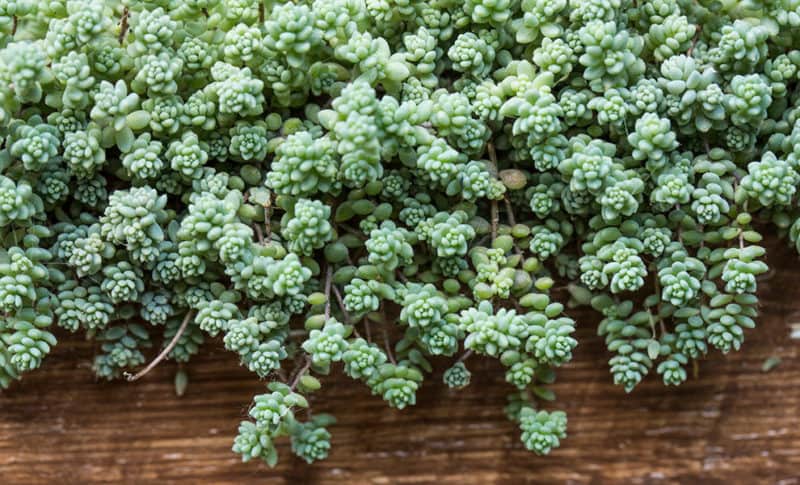
Sedums are another fabulous succulent family for vertical gardens. They spread quickly and are great for filling in garden gaps. In addition, they have shallow roots, are drought tolerant and don’t need much fertilizer.
Ferns
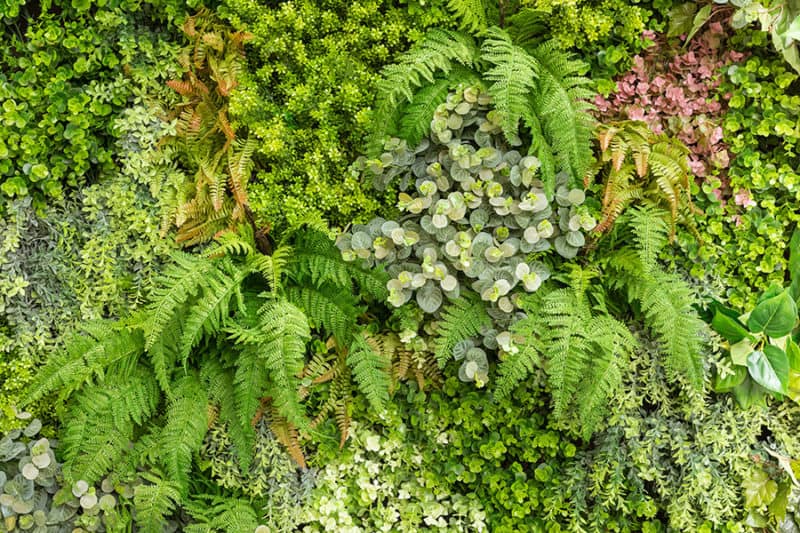
Ferns do well in low light and moist conditions. Choose fern varieties that are small and compact like Adiantum, Dryopteris, and Cyrtomium.
Sword fern has proven to be a good one for green walls. The delicate leaves contrast nicely with larger leafed plants such as pathos.
Other good ferns to grow are blue star fern and bird’s nest fern.
Herbs
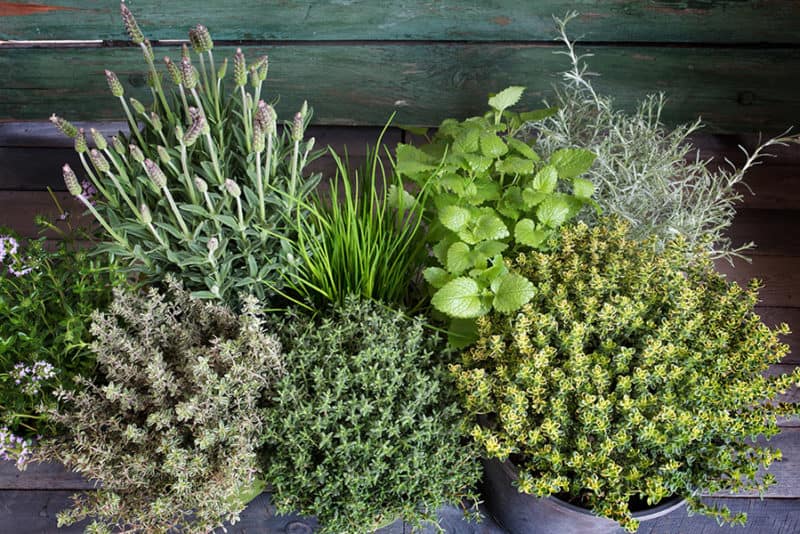
What better way to have a fresh herb supply around when cooking than to have them growing right on the wall.
Herbs do well in an indoor or outdoor vertical wall system and easily adjust to the confinement of smaller spaces. A few herbs, such as mints and sages, need pruning or frequent harvesting to keep them in check.
Herbs such as mints, thyme, sorrel, and lemon balm can tolerate lower light conditions. Other herbs such as chives, basil, parsley, and sage need a supplemental plant light if they’re indoors.
Herbs need a light potting soil mix. Many of them grow well with an organic fertilizer such as fish emulsion given once in spring and once in summer.
Vegetables
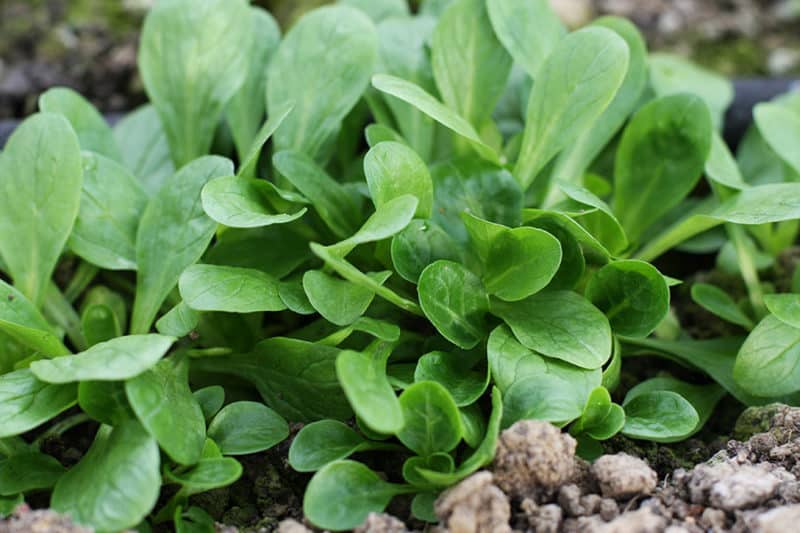
One of the most fun and popular things to do with your living wall is to have a salad garden. Lettuces and greens do exceptionally well growing this way. If you are growing a living wall indoors you will need to have artificial grow lights.
Lettuces, arugula, spinach, radishes, small carrots, baby beets, and mache are all ideal. Leaf lettuces varieties such as baby oakleaf, red sails, red salad bowl, and deer tongue are also good options. These plants have shallow root systems, are compact and don’t require pollination.
Small cabbages are also a viable option. Consider varieties like mini Caraflex., napa cabbages, and smaller Pak Choys.
Vegetables grown indoors have higher fertilization needs. Give them a weak solution of organic fertilizer to keep them healthy.
If your living wall is located outdoors, you can add some larger or cascading veggies to your arrangement. Check out cherry tomatoes, Asian cucumbers, green beans, and peas. For fruits, strawberries and blueberries do nicely.
These fruits and veggies do best outdoors because they have pollination requirements. However, you can have them inside by utilizing grow lights or a sunroom and hand pollinating.
Flowers
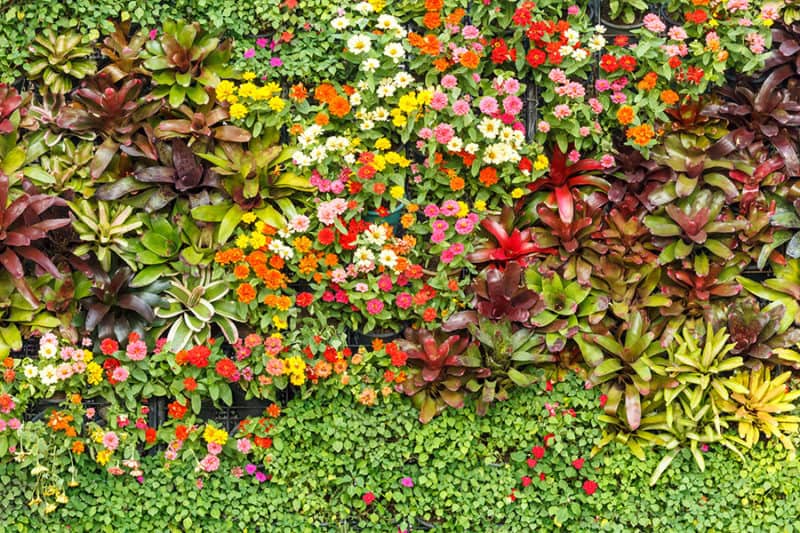
Flowers bring beauty and fragrance to your living wall. Petunias, nasturtiums, and impatiens are flowers that like bright light and do well in compact quarters.
Pansies, viola, vincas, begonias, and coral bells do well with low light. Pothos is a popular houseplant that does particularly well in a living wall. It has a vine-like growth habit and forms a beautiful cascading wall of green.
Pothos looks great combined with pansies to add some pretty blooms and with coral bells to contribute some red and orange leaf colors.
Mix and Match
Remember that living walls are an empty canvas. Don’t hesitate to mix and match your favorite herbs, vegetables, and flowers. Your imagination is the limit.
With a living wall, you have separate areas for plants. This allows you to adjust the soils and fertilizer individually. You can put higher light needs directly under a grow light and low light pants on the sides.
Or you can put hungry plants in one container next to low-fertilizer plants. Unlike a traditional garden, plants with totally different needs can grow side by side.
Great DIY Project
Vertical plant walls are a fabulous DIY project. They are actually surprisingly simple to build. Most often they consist of a box with shelves to hold the plants and some holes to provide irrigation tubing.
Ready for a great DIY project? This video from Home Depot will walk you through building a vertical living wall that you can hang inside or outside your home.
The Perfect Place for a Living Wall
There really is no wrong place for a living wall, but there are a few spots that are particularly perfect.
Bathroom Wall
Putting a living wall in your bathroom makes it feel like a spa. Use mosses that enjoy the humidity of the bathroom to create a dramatic yet cozy environment.
Accent
Vertical walls add interest to transition areas in your home without taking up much space. Provide a stunning accent with a living wall that can brighten up a hallway or make a set of steps intriguing.
Privacy Fencing
Make your plant walls work for you by providing an element of privacy for your home. For instance, you can use them in front of your home or around an outdoor kitchen.
Meditation or Yoga Area
Do you have a minimalist area that you use for relaxation and refocusing? A living wall helps to give that area a connection to the earth and give you that zen feeling.
Kitchen
In winter, you may not be able to enjoy your patio or backyard barbecue space. Plants in the kitchen are a great way to bring the summer cooking feel indoors.
Even better, make your living wall edible. There are many herbs and greens that do well in the living wall. Wouldn’t it be fun to pick your evening salad inside while the cold winter winds blow outside?
Living Walls Let You Garden in the Smallest Spaces
Living walls are a wonderful way to expand your gardening space. They allow you to bring some of nature inside to enhance your home with beautiful blooms and delicious edibles.
